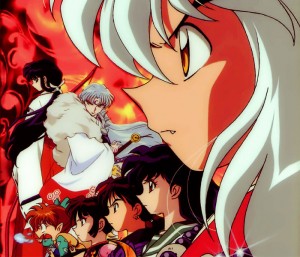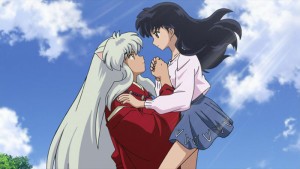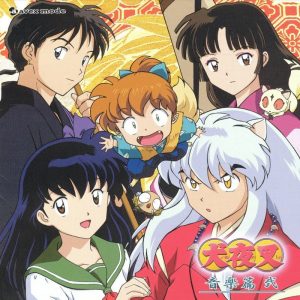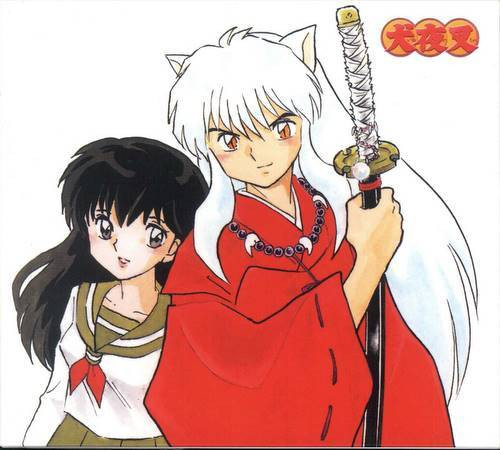
A Feudal Fairy Tale Worth Remembering
- Episodes : 167
- Aired : October 2000 – September 2004
Kagome Higurashi gets a big surprise on her 15th birthday when a centipede demon pulls her into the sealed well at her family’s Shinto shrine and finds herself transported back in time to a yokai-filled Sengoku period in feudal Japan. Kagome discovers she is the reincarnation of powerful Miko priestess Kikyo and has the magical wish-granting Shikon jewel within her body which drew the demon to her.
When the centipede monster attacks again, Kagome ends up freeing half-demon Inuyasha to fight it off. The jewel is shattered shortly after, so it’s up to the reluctant duo of Kagome and Inuyasha to recover the pieces before the many demons of the world can abuse its power. They are soon joined by the lecherous priest Miroku, demon-slayer Sango, mischievous fox demon Shippo, and other allies, in a story full of time-traveling adventure, yokai battles, dramatic romance, a bit of comedy, and a lot of soul(s).
This article is a light review, with a bit of a nostalgic remembrance for this classic series.
Contains Spoilers
InuYasha’s Strengths
First and foremost, InuYasha has a great cast of characters, each has strong personalities that play off of each other well. While there’s a lot of simple enjoyment to be found in the series, including many running jokes such as Miroku’s over-the-top flirtation with nearly every woman he encounters and Kagome’s use (and abuse?) of the Beads of Subjugation on Inuyasha, there is also real character development and ample exploration of their, largely tragic, backstories that makes your understanding of each character deeper and more memorable, often even when it comes to villains.
Another standout is the series’ music. Like many other anime, InuYasha has some great opening and ending themes provided by likes of Do As Infinity, Namie Amuro, and Every Little Thing, but InuYasha really distinguishes itself with its original soundtrack. Maestro Kaoru Wada’s work for InuYasha is monumental, expertly mixing traditional Japanese instruments and musical flair with the versatility and production quality of a modern orchestra to great effect. Diverse and beautifully complex, with smart use of leitmotif, the music of InuYasha really adds a lot to the experience!
Other highlights of InuYasha include the high quality of the artwork and animation, especially for its time and long run, the interesting fantasy-historical setting and variety of enemies our heroes face, many drawing from traditional Japanese folklore, and some fun use of time travel.
Dog Days - The Series’ Shortcomings
While overall InuYasha is a great series, it does have some drawbacks, the most notable being its fairly frequent reused footage to provide a recap of the previous episode(s) which becomes quite noticeable when watching many episodes back-to-back. In general, InuYasha can also be a bit repetitive at times as they face yet another “demon of the week” or the main antagonist escapes. Sometimes the plot and character development can be slow but, especially when viewing it from the standpoint of it being made for broadcast television expecting long reruns, this is mostly forgivable.
InuYasha and the American Anime Experience
We wanted to make special mention of InuYasha as a series this was important in the early(ish) days of anime fandom in America. InuYasha was one of the first “mature” anime series to get major broadcasting stateside that had major appeal to both sexes thanks to its mix of romance and action. In America, it was broadcasted on Adult Swim originally from 2002 to 2006 and, as a testament to its popularity, had reruns up until 2014!
Moreover, it can be speculated that InuYasha’s overt Japanese setting and theming made it easy for fans to understand it as being different from Western animation, letting them better understand it as uniquely anime. Staying up past your bedtime to catch InuYasha on a weird late-night TV block is a shared memory many fans can cherish from their younger days.
Final Thoughts
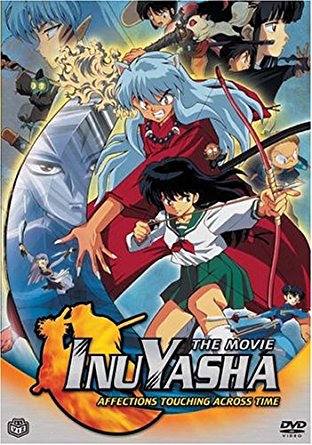
Altogether, InuYasha is an anime series that perhaps deserves a little more praise and discussion in the modern age. With its impact in helping to popularize anime in the West, along with its inherent worth as a work of art, Sunrise’s adaptation of Rumiko Takahashi’s beloved manga stands as both something that is a product of its time to look back upon and potentially, depending on how you think about it, one of the most tastefully done isekai anime ever. When viewed as a casual late-night watch, InuYasha is practically perfect, and it’s still enjoyable enough to take the 167 episode plunge for nostalgic fans and newcomers alike if spaced out properly.
In any case, we hope you enjoyed this little trip back in time, albeit not quite to the feudal era. Please leave a comment below about your experience with InuYasha, be it your favorite character, pick for best OP/ED, coolest special attack (Iron Reaver Soul Stealer all the way!), or anything else you’d like to share!
Recommended Post
6 Anime Like Inuyasha [Updated Recommendations]
Recommended Post
Top 10 Strongest InuYasha Characters [Best List]
Recommended Post


